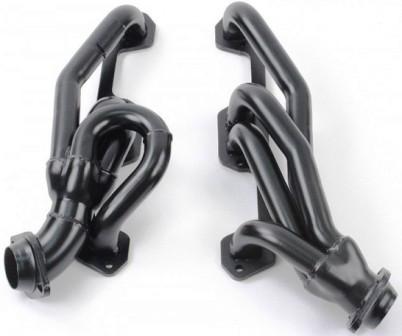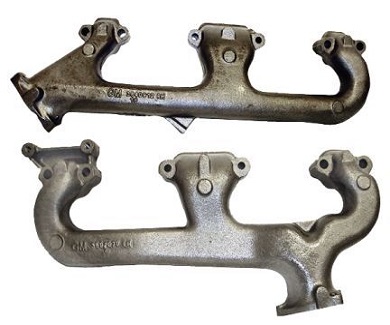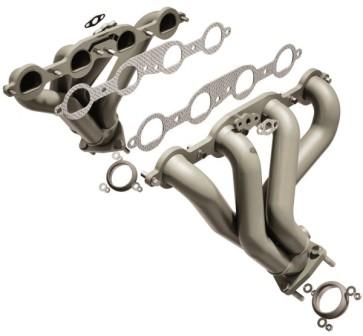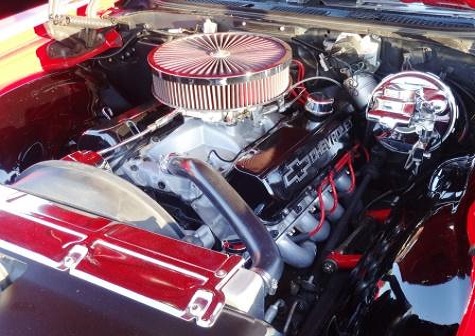
It’s not too difficult to find a few reasons to upgrade the exhaust headers on your classic car. Not only do they sound amazing at idle, but the further you push your foot down on the gas pedal, the better they sound. Although this upgrade remains popular, because of the noise a tuned exhaust header creates, there is actually a scientific reason to go for this aftermarket upgrade.
Coincidentally, it becomes the perfect complement for the intake manifold upgrade that we discussed last week. If we relate both of these upgrades to how an athlete performs we can better understand why we’ll see a big boost in horsepower. The intake manifold represents the inhalation of oxygen for a human being. The exhaust manifold represents the exhale, but more importantly, the ability to expel all of the air from the lungs. This allows us to take in the maximum amount of oxygen on the next inhale.
In the case of a classic muscle car the intake and exhaust manifolds left a lot to be desired. Imperfections in the casting slowed down the intake of air and fuel. In the same way the sharp bends and rough inside castings of a standard exhaust manifold reduce the flow of exhaust. If we only increase the ability for the intake to pull in more air and fuel, without increasing flow on the exhaust side we don’t reap all of the benefits. So let’s talk about a few reasons to upgrade the exhaust headers.
Benefits of Exhaust Manifold Upgrades

Let’s take a good look at the factory installed cast-iron exhaust manifolds. On a classic muscle car era automobile you’ll find a compact part with 90 turns and ports that share the task of removing exhaust fumes from multiple cylinders. These exhaust manifolds are so inefficient that it actually creates back pressure in the combustion chamber. In other words, exhaust gases don’t flow out fast enough to empty the cylinder.
As mentioned above, this slows down the intake process and limits the amount of air and fuel charge entering for the next cycle of combustion. In turn, this restriction of exhaust flow robs the engine of generating its full ability to produce horsepower and torque. When using an aftermarket exhaust header you find dedicated tubes for each cylinder. In addition, you find that the surfaces inside are highly polished.
Finally, you won’t find a 90 degree turn in an exhaust header. Instead the exhaust takes a long flowing turn that enhances the ability to remove exhaust gases from the combustion chamber. This improves the volumetric efficiency of the engine. Therefore, we can say high-performance exhaust headers provide enhanced efficiency, because of the large diameter tubing, long flowing bends and polished inside surfaces to reduce drag and back pressure.
Upgrade the Exhaust Headers the Downside
Unfortunately, the design of aftermarket headers with their large diameter tubes and long flowing lines often interferes with other auto parts. The factory installed these compact manifolds because they didn’t have the room in the engine compartment. With that said, they also didn’t see it as the best way to increase horsepower at the time. Nevertheless, installing aftermarket headers on some classic muscle cars presents major challenges.
Let me give you an example of common problems when you upgrade the exhaust headers. I installed a pair of Lakewood performance exhaust headers on a friend’s Dodge Charger RT. Long story short, the header installation on the big block 440 cubic inch engine became a nightmare. We purchased model specific parts from a reputable Mopar specialist that designed the headers specifically for the Dodge Charger application.
However, we still had to take the engine loose from the motor mounts and use a hoist to lift the engine up to install the headers. In addition, interference with the upper control arms and the tie rods became another issue. After we completed the installation the true problems began to surface. In order to clear some suspension parts the driver side header becomes the lowest part under the automobile. After going over a few speed bumps the tubes that carried exhaust gases from the front cylinders became completely smashed closed. Instead of increasing efficiency the end result became exactly the opposite.
I Feel the Need, the Need for Speed

There are a lot of other areas in the engine compartment where we can find room to increase horsepower. In fact, you can even find an article about nitrous oxide upgrades you can put in the trunk to provide the boost you’re looking for. But no matter where we decide to boost performance, deciding to upgrade the exhaust headers maximizes the benefits of all the other alterations.
However, it’s the classic muscle cars that benefit the most from switching to an aftermarket exhaust manifold. I’m talking about cars like the Chevrolet Malibu Super Sport and the Ford Mustang pony cars. These automobiles utilized some of the most inefficient exhaust manifolds ever created by man. It’s not that the original designers of these engines did not understand volumetric efficiency, they just approached the horsepower wars in a different way. They decided to increase combustion ratios and cubic inches to achieve the desired performance level. Of course, they also had leaded fuel available to them at the time.
However, as time went on car makers found themselves in a position where they had to increase fuel economy and reduce vehicle emissions to meet tightening government regulations. This forced them in the direction of improving the intake and exhaust cycles on modern automobiles. Therefore, the general rule of thumb becomes the newer the automobile the less performance gains you’ll find from upgrading the intake and exhaust manifolds. Why? It’s because the automotive manufacturers upgrade the exhaust headers on their own. They also do a good job on the intake side of manufacturing efficient cold air intakes and intake plenums installed on the assembly line.

